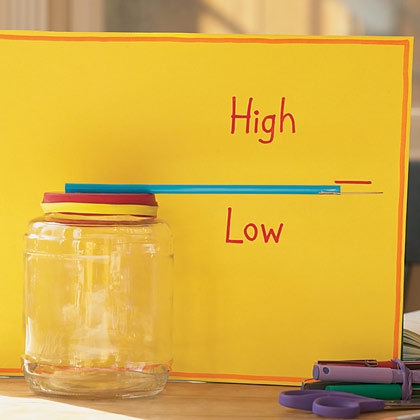Balloon Barometer - Science Fair Projects

Earth's atmosphere surrounds the planet; it is the mixture of gases we breathe as air. As weather patterns move around, air particles may “bunch up” over a particular area. More particles mean increased atmospheric pressure.
When pressure is high, it prevents clouds from forming, and the weather is likely to be fair. When air pressure is low, clouds form more easily and there is a greater chance of rain or snow.
In this experiment, you will build a simple barometer and measure changes in atmospheric pressure.
What you will need:
- A jar with a wide base and a narrower mouth
- A balloon
- Rubber band
- Rubber cement
- Drinking straw
- Scissors
- Graph paper
- Marking pens
What to do:
- Flatten one end of the drinking straw with your fingers, making about 1 inch of the straw flat. Use the scissors to clip the flattened end to a sharp point. It may be helpful to color this pointer with a bright color to make it easy to see.
- Cut a piece out of balloon and stretch it tightly over the mouth of the jar. Use the rubber band to secure this membrane over the mouth of the jar like the top of a drum. The air trapped inside will stay at a fairly constant pressure because air particles can neither enter nor escape through the balloon covering the mouth of the jar.
- Apply a strip of rubber cement along the stretched balloon from the center of the jar mouth to the edge. Fix the unflattened end of the drinking straw to the rubber cement so that most of the length of the straw, and the pointed end, protrudes past the edge of the jar. The straw should stick out at least 6 inches from the edge of the jar.
- Divide a piece of graph paper into 7 columns, one for each day of the week. Tape the graph paper to a wall in a sheltered outdoor location and position your bottle barometer so that the tip of the straw is very close to (but not quite touching) the graph paper. Mark the graph paper to show the position of the barometer tip on the appropriate day. In your notebook, record the time of day and some notes about the weather conditions.
- Move the barometer over to the next column and repeat your observations at the same time of day for at least three weeks replacing the graph paper as needed.
Results
If the weather has changed during your observational period, you should have noticed some corresponding changes in the position of your barometer’s tip. When air pressure is high, the air outside of the bottle will be heavier than the air inside of the bottle. The balloon will be sucked down into the bottle pushing the opposite end with the pointed tip higher on the graph.
Remember that high pressure usually means fair weather. When the air outside of the bottle is less dense than the air inside of the bottle (air pressure is low), the air inside the bottle will press against the balloon membrane. The balloon will stretch a little causing the pointer to be lower on the graph. Low pressure usually means a greater chance for rain or snow in the near future.
Sign up for the Live Science daily newsletter now
Get the world’s most fascinating discoveries delivered straight to your inbox.










